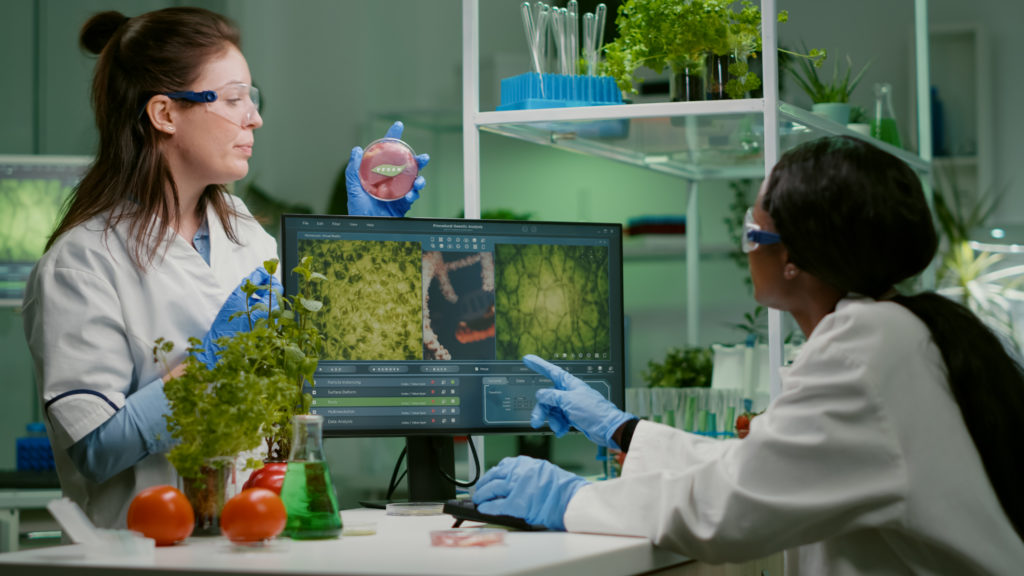
Project INSIGHTS REPORT
Emerging agricultural technologies and the future of food: Exploring potential
Tech and Automation, Sectors in Transition
Executive Summary
Cellular agriculture is a suite of technologies to grow proteins indoors, with minimal or no use of live animals. Products have the potential to be local, reliable dairy and meat alternatives with low environmental footprints and can be produced in industrial, urban and rural spaces.
This project engaged people working in agriculture and food sectors, NGOs, technology developers, entrepreneurs, social science and natural science researchers, educators, and students to explore the viability of a regional cellular agriculture industry in the Lower Mainland of British Columbia.
Through interviews, discreet research projects, a survey, learning exchanges, and workshops this project identified guiding principles and next steps for the cellular agriculture industry in this region and across Canada. Project partners encouraged efforts to foster relationship building across the wide range of stakeholders involved in cellular agriculture, increase efforts to educate the public, diversify investment to foster broader participation in the industry, and to continue to explore how this emerging industry can contribute to environmental and social objectives.
The project partners concluded that depending on its timing and level of engagement, British Columbia could be a leader in the production of cellular agriculture products, including as a resource base for producing feedstock and other inputs for cellular agriculture production. Doing so would also allow the province to help define environmental, social and governance product standards, increasing the likelihood of cellular agriculture delivering on its potential.
Date Published
March 2024
Partners
University of the Fraser Valley
Locations
British Columbia
INvestment
$223,417
Key Insight #1
Cellular agriculture is mysterious and unfamiliar to much of the public, and the media communications around the technology have not adequately informed the public about its nature and potential opportunities and challenges.
Key Insight #2
Those who identified as male and those with a university education were more willing to try and likely to buy cellular agriculture products regularly, compared to those who identified as female and those with a college or non-university education.
Key Insight #3
Cellular agriculture presents unique opportunities for using waste streams as feedstocks for developing products. However, such waste-to-feedstock opportunities are very challenging and expensive.
 The Issue
The Issue
The need to transition toward a sustainable food and agriculture system is critical and widely recognized. The current food and agriculture system contributes to many sustainability issues and environmental pressures, including the production of greenhouse gases, overconsumption of water, freshwater pollutants, and loss of habitat and biodiversity. Simultaneously, agriculture is highly vulnerable to flooding, extreme heat, drought, and loss of soil quality. Such impacts have severe effects on the livelihoods and wellbeing of producers, their communities, and society at large. As diets change and the global population grows, there is a need to explore new ways of producing and distributing food in ways that contribute to sustainable and resilient futures.
Cellular agriculture refers to a suite of technologies to grow proteins, like dairy or meats, indoors with minimal or no use of live animals. This technology has the potential to reduce emissions related to livestock production, sparing land for possible biodiversity conservation, and minimizing pressure on wild fish stocks. It could also contribute to food system sustainability, animal welfare, and resilience.
Other countries are developing regulations, incentivizing research, and supporting production and sale of cellular agricultural products. However, cellular agriculture triggers many social and economic questions. For example, there is concern regarding the potential livelihood implications of these technologies for livestock farmers and agriculture workers. Other research has demonstrated that the public has concerns about cellular agriculture. The positive impacts of this form of agriculture cannot be realized without adequate consumer acceptance and demand.
 What We’re Investigating
What We’re Investigating
This project explored the opportunities, challenges, and key considerations for developing a cellular agriculture industry in British Columbia (and broadly Canada) in ways that support transitions to sustainable food futures. Through interviews, discreet research projects, a survey, learning exchanges, workshops, and meetings, the project engaged people from NGOs, industry, government, research institutions, Indigenous communities, and the broader public to explore social, environmental, and economic opportunities and challenges around developing a local/regional industry.
The project included:
- A three-day, in-person learning exchange in 2022 on the social implications of cellular agriculture with people working in agriculture and food sectors, NGOs, technology developers, entrepreneurs, social science and natural science researchers, educators, and students.
- Feedstock studies and supply chain mapping on cellular dairy production in the Fraser Valley.
- Coordinating and inviting submissions to a special issue in Frontiers in Sustainable Food Systems. The topic of the issue is The Social Implications of Cellular Agriculture and the Future of Food.
- A survey that explored public perceptions of 504 residents of Metro Vancouver towards cellular agriculture opportunities and the potential cellular agriculture has for enhancing food security, economic development, and sustainability in Canadian communities. The survey explored:
- How Metro Vancouver residents viewed possible transitions to cellular agriculture with respect to likely, ideal, and concerning food futures.
- The demographic factors associated with willingness to try and likelihood of buying cellular agriculture products.
- Possible and/or desirable future scenarios for cellular agriculture’s emergence in public food systems including access, centralization and integration.
- A virtual workshop in 2023 where students, researchers, startup innovators, and non-profit leaders who engaged in the research at some stage throughout the two-year duration of the project shared their insights and lessons for orienting the development of the cellular agriculture industry toward sustainable food futures.
 What We’re Learning
What We’re Learning
The project yielded several insights to guide development of a local/regional cellular agriculture industry in the Lower Mainland of British Columbia.
Building and deepening engagement and relationships. The emergence of cellular agriculture can result in significant fear and anxiety for a range of stakeholders. A just transition of the protein industry, including the development of cellular agriculture industry, requires increased and meaningful engagement between industry, academia, government, and local communities, especially with Indigenous communities, as cellular agriculture decouples people from animal foods which may conflict with the interdependence at the center of many Indigenous ontologies. Relationship building takes time, and researchers and startups working in this space should ensure appropriate time and resources are allocated to relationship building to build trust and offer transparency. This process of relationship building is often more complex than anticipated, and it is critical for those who want to embark on this work to do so with humility and following principles of reciprocity, consent, accountability and trust.
Increasing public knowledge and transparency: There is still relatively little public understanding and familiarity with cellular agriculture and there is a need for transparent communication strategies to educate the public regarding cellular agriculture, recognizing that diverse communities may have values that are in line and/or in tension with this technology. As the industry grows, public education and engagement is important to improve literacy and inclusion in the industry. Cellular agriculture could gain public acceptance if it contributes to food systems in a beneficial way, for example making foods more accessible with respect to low cost and high availability, as well as the proliferation of local businesses.
Challenges to industry development and growth. Canada is a new player in the global cellular agriculture industry. Without increased public support in the form of interdisciplinary training and technical skills development, funding, and incentives for open innovation and knowledge sharing, there is limited potential for the industry to develop in inclusive and holistic ways. Technological development within cellular agriculture is primarily driven by the private sector, with many of the lessons and knowledge around the technology being protected as intellectual property. As a result, the cellular agriculture industry is at risk of becoming highly centralized and operated by only a few large firms, with less opportunity for competition or broad-based public participation.
Food systems sustainability: Cellular agriculture could contribute to critical ecological sustainability objectives related to biodiversity and ecosystem health, but the technology does not guarantee such benefits. It could also contribute to climate change mitigation, but it does also present climate change concerns. Further research is required to better understand and enable cellular agriculture’s contribution to environmental sustainability, including the development of comprehensive environmental, social and governance metrics, implementation with sustainable energy systems, and integration within circular economies.
 Why It Matters
Why It Matters
Cellular agriculture companies that are exploring analogues to relatively inexpensive animal products, such as chicken, experience particularly large challenges with respect to long-term viability, as it is difficult to compete with the economics of conventional livestock. Scaling up production is necessary for economic viability, which requires several hundred million dollars of capital to support. Further to this, many of the processes and equipment required for large-scale operation have yet to be developed to achieve economies of scale, and training institutions have yet to develop programming to support their use.
If cellular agriculture were to become a component of future food systems, it is important to consider from where the investment and funding will be sourced. The primary source of funding for the industry currently is venture capital, which is not ideal considering its lack of consistency, secrecy, and shorter-term return on investment cycles. This brings forward key questions about whether/how cellular agriculture can be supported by diverse forms of long-term funding, such as academic-industry grants and public investment into research and development hubs.
Identifying the key stakeholders and government agencies that need to collaborate in shaping the cellular agriculture industry is challenging. Cellular agriculture is a food production method that also firmly exists within the realm of biotechnology, and the emerging industry requires the same level of investment, infrastructure, and support as the biotechnology sector for it to flourish. The confusion around where cellular agriculture exists with respect to its sector can create challenges for government agencies: under whose purview should the industry lie?
As the cellular agriculture industry emerges, it is important to consider the timing around when British Columbia and Canada will engage in the industry. This is particularly important for British Columbia, where existing agricultural land constraints as well as supply chain concerns, as observed during the 2021 flooding, are top-of-mind. Depending on its timing and level of engagement, the province could be a leader in the production of cellular agriculture products, as well as help define environmental, social and governance product standards. Alternatively, the province could serve as a resource base for producing feedstock and other inputs for cellular agriculture production, including possibly through re-purposing agricultural waste products. Specific opportunities include developing strategic partnerships along the west coast of North America toward the concentration of startups in Silicon Valley, in addition to building upon the Lower Mainland’s already robust agricultural research and innovation infrastructure and traditions.
 What’s Next
What’s Next
Future work that builds on the foundations and networks developed through this research include two new cellular agriculture research efforts. One is supported by Genome BC on ways of developing an ethical research space for engaging Indigenous communities in the use of cellular agriculture technologies and growth of the industry. A second project supported by Genome Canada, looks at how cellular agriculture (and other agricultural technologies) can be developed in ways that both contribute to climate change mitigation objectives and align with social justice and equity principles.
More from FSC
Digital Infrastructure for the Post-Pandemic World
Canadian Alliance for Skills and Training in Life Sciences (CASTL)




